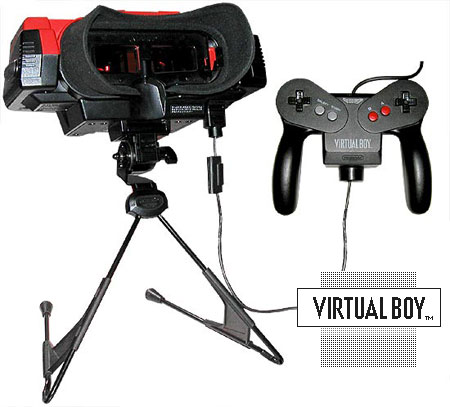In the wee hours of the night, word got out that Nintendo is going to release what’s tentatively being called the 3DS, a handheld 3D console, between April 2010 and March 2011, with more details to follow at E3 in June.
As timely as the device “on which games can be enjoyed with 3D effects without the need for any special glasses” might sound in light of the current, post-Avatar craze for home 3D, coming as it is from Nintendo, the 3DS conjures up another, maybe unwelcome connection: The mid-’90s’ disastrous Virtual Boy, whose revolutionary promises of immersive VR in your living room only managed to give a bunch of gamers headaches in the comfort of their own living rooms and sell 800,000 units over its entire lifespan of a year.
Fortunately, it looks like Nintendo has managed to learn its lesson since then:
Here’s the 3DS press release from Nintendo’s website: (warning: PDF)
Nintendo Co., Ltd. (Minami-ward of Kyoto-city, President Satoru Iwata) will launch “Nintendo 3DS”(temp) during the fiscal year ending March 2011, on which games can be enjoyed with 3D effects without the need for any special glasses.
“Nintendo 3DS”(temp) is going to be the new portable game machine to succeed “Nintendo DS series”, whose cumulative consolidated sales from Nintendo amounted to 125 million units as of the end of December 2009, and will include backward compatibility so that the software for Nintendo DS series, including the ones for Nintendo DSi, can also be enjoyed.
We are planning to announce additional details at E3 show, which is scheduled to be held from June 15, 2010 at Los Angeles in the U.S.
Let’s take a trip down memory lane, to 1994, when the Virtual Boy came out. Nintendo’s release at the time:
Nintendo, the world’s largest manufacturer and marketer of video games, today announced the introduction of “Virtual Boy”(TM), the first virtual reality system developed and produced for the mass market. The RISC-based, 32-bit system utilizes two high-resolution, mirror-scanning LED (light emitting diode) displays to produce a 3-D experience not possible on conventional television or LCD screens.
Virtual Boy’s unique design eliminates all external stimuli, totally immersing players into their own private universe with high-resolution red images against a deep black background. The 3-D experience is enhanced through stereophonic sound and a new specially designed, double-grip controller which accommodates multidirectional spatial movement.
It’s interesting to compare the two. The most obvious difference is that the 3DS release is lighter on details, which are of course to be announced at E3, but there’s also the matter of overpromising: the Virtual Boy release manages to whip up a swagger (“the first virtual reality system developed and produced for the mass market”; “a 3-D experience not possible on conventional television or LCD screens”) that’s not present in the chipper, more straightforward 3DS release, which doesn’t seem like it’s trying as hard to prove something (“…on which games can be enjoyed with 3D effects without the need for any special glasses”). Keep in mind that as funny as it is to reminisce about today, the Virtual Boy was generally considered a pretty awful system in its day, with a very limited catalog and a headache-inducing goggle setup.
For context, here’s the Angry Video Game Nerd’s tour de force review of every single game in the Virtual Boy’s catalog:
Chalk it up to more sophisticated consumers (and media outlets), who aren’t as easily swept in by claims about what virtual reality is and isn’t as they might have been in 1994; to the 3DS release’s appearing on a Japanese site; to the painful lessons learned by having once released a product called the “Virtual Boy,” whose name must have come up in some meeting or another. But in any event, there’s more modesty about the enterprise now than there was in 1994, and that’s a good thing.
(via Planet Virtual Boy and Kotaku)










Published: Mar 23, 2010 09:06 am